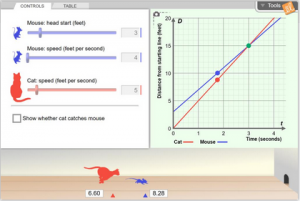- Home
- Resources
- Success Stories
- Success Story Article
Gizmos shows district's students (and teachers) how math fits into a bigger picture

Ms. Susan Stanbery first started using Gizmos as a classroom teacher ten years ago. Now that she’s a Math Instructional Specialist for grades 6-12 in Campbell County Schools, Virginia, the district purchased Gizmos for secondary math teachers “so that our teachers would have access to math labs and could help students learn how certain math topics fit into a bigger picture. I also had teachers confess that they, too, lack understanding as to how the math they teach fits into a bigger picture. Our state provides a vertical articulation document, but without K-12 conversations or work within professional learning communities, that document grows cold. Gizmos has helped us in that respect.”
Gizmos has helped her math teachers in many ways. Her middle school math teachers “have also asked for more ideas and hands-on lessons to help them promote understanding in the classroom. I can’t think of a better vehicle to make that happen than Gizmos. We, like other school divisions, have spent a great deal of time and effort on student achievement–sometimes at the expense of learning. Our teachers want students to be problem-solvers, not just ‘do-ers’ of math with algorithms. Historically, teachers tend to teach how they were taught. I am proud to say that we have a large number of teachers who want to leave that model behind and move toward facilitating mathematical understanding in their students. Gizmos support that goal by providing teachers with both the teacher guide as well as the student exploration guide. That alone helps provide teachers with a bigger picture of the math than simply ‘getting through a lesson.'”
Ms. Stanbery explains, “I have spent a great deal of time during the last 3 years in the 6 – 8 classrooms helping to provide students with rich experiences so they can demonstrate their mathematical reasoning and problem-solving skills. Regardless of whether the class is a co-taught class or an advanced class, the goal is to help students learn to represent the math in a way that makes sense to them. We strive to use manipulatives and pictorial representations long before getting into the symbolic notation. Roughly 10% of our middle school math classes are co-taught were we serve students with IEP’s. We have also recently changed our Program of Studies to slow down the path to Algebra 1 so that 6th- and 7th-grade students are spending time learning fraction operations, proportional reasoning, and functions by modeling (versus memorizing algorithms first). The objective is to provide a deep study of the math so that they have a strong foundation of the math concepts that they will build upon in high school.”
 “Gizmos have helped me in my current position because I can now help teachers learn the why behind what they are teaching. For example, in 6th grade, students learn how to add, subtract, multiply, and divide fractions. They also continue to use the operations with decimals. If I observe a lesson where the teacher demonstrates a math problem with an algorithm (i.e. counting the number of decimal places and then moving the decimal that many times), I ask them if they know why it works. Often, they say no. So I will offer the use of base 10 blocks. Most of our secondary teachers have never used manipulatives in their teacher prep programs, or the use has been limited. Instead of teaching the base 10 blocks, I refer them to the Gizmo Multiplying Decimals (Area Models). I ‘assign’ them the task of reading the teacher guide and the student exploration guide–and not to use the interactive part of the Gizmo. We come back together to discuss the purpose of the lesson and why the modeling is important. Then, together, we work through the Gizmo. Afterward, I show the teacher how it aligns with the multiplication of whole numbers using partial products and binomial multiplication in Algebra. Most teachers feel empowered after our session because their own depth of knowledge has been improved. They can see the value in reading the documents before accessing the Gizmo. I then offer to co-teach with them when the time comes to use the Gizmo. It is important that best-practice is used to get the best results.”
“Gizmos have helped me in my current position because I can now help teachers learn the why behind what they are teaching. For example, in 6th grade, students learn how to add, subtract, multiply, and divide fractions. They also continue to use the operations with decimals. If I observe a lesson where the teacher demonstrates a math problem with an algorithm (i.e. counting the number of decimal places and then moving the decimal that many times), I ask them if they know why it works. Often, they say no. So I will offer the use of base 10 blocks. Most of our secondary teachers have never used manipulatives in their teacher prep programs, or the use has been limited. Instead of teaching the base 10 blocks, I refer them to the Gizmo Multiplying Decimals (Area Models). I ‘assign’ them the task of reading the teacher guide and the student exploration guide–and not to use the interactive part of the Gizmo. We come back together to discuss the purpose of the lesson and why the modeling is important. Then, together, we work through the Gizmo. Afterward, I show the teacher how it aligns with the multiplication of whole numbers using partial products and binomial multiplication in Algebra. Most teachers feel empowered after our session because their own depth of knowledge has been improved. They can see the value in reading the documents before accessing the Gizmo. I then offer to co-teach with them when the time comes to use the Gizmo. It is important that best-practice is used to get the best results.”
Teachers in her county use Gizmos mostly with small groups. “Our teachers have class sets of laptops and access to an interactive whiteboard. The students are provided the warm-up question and given time to answer it and discuss with their shoulder partners. Then classroom discussion ensues. Afterwards, the teacher will demonstrate the Gizmo and its use–reviewing the keys and the camera if necessary. Then students are given the code or allowed to log onto the computer with their assigned activity. The teacher serves as facilitator.”
“One of my favorite Gizmos is Percents, Fractions, and Decimals. When asked, teachers will usually say that is their least favorite topic to teach. It is difficult to teach these as a blended unit and teach it well. Thankfully, the Gizmos lesson is fantastic. Not only does the Gizmo provide a great visual in the shading of the grid, the grid does not have to be a 10 x 10 as most teachers present it. This allows for higher-order questioning from the teacher. When we meet, I ask teachers what problems the students have with FDP. Once they identify it, we look at the Gizmo and the teacher identifies which issues are addressed in the lesson and on which parts we can pause to ask deeper questions. We practically script a lesson using the Gizmo as the basis.”
 “When we do the Cat and Mouse (Modeling Linear Systems) Gizmo, I cut and paste the warm-up activity on the interactive board and we do the ‘race’ as a demonstration using just a couple of students. Then we discuss the lesson and the intent of the lesson. We call a time-out every section and discuss what they are learning as they complete the Gizmo. To end the lesson, I post the assessment questions one-by-one to the entire class. I will usually hide the multiple choice answers and see what the students do. Then, I unhide the answers. I challenge students to see if their answer is present and if the answer makes sense in the context of the problem. Often, it is revealed that the students don’t pay attention to the distance of the mouse hole. In my experience, most students are not successful on the assessment because they have assumed too much (or not paid attention to the scales of the graph). After discussing the first 2 questions, their understanding has improved and we provide time for them to modify the answer to the rest of the questions. It’s a rich lesson!”
“When we do the Cat and Mouse (Modeling Linear Systems) Gizmo, I cut and paste the warm-up activity on the interactive board and we do the ‘race’ as a demonstration using just a couple of students. Then we discuss the lesson and the intent of the lesson. We call a time-out every section and discuss what they are learning as they complete the Gizmo. To end the lesson, I post the assessment questions one-by-one to the entire class. I will usually hide the multiple choice answers and see what the students do. Then, I unhide the answers. I challenge students to see if their answer is present and if the answer makes sense in the context of the problem. Often, it is revealed that the students don’t pay attention to the distance of the mouse hole. In my experience, most students are not successful on the assessment because they have assumed too much (or not paid attention to the scales of the graph). After discussing the first 2 questions, their understanding has improved and we provide time for them to modify the answer to the rest of the questions. It’s a rich lesson!”
Ms. Stanbery adds, “When we have our curriculum meetings where we update pacing guides, our teachers are eager to attach links to correlated Gizmos. They have learned to modify their own strategies so that it’s not simply a matter of handing students the exploration guide and tuning out. They are continually honing their craft to promote reasoning, collaboration, and communication among the students.” Gizmos help “promote understanding of the math that is being learning and that, in turn, promotes student interest and motivation.”
 Susan Stanbery taught Algebra 1, Advanced Algebra 2, and AP Statistics at Heritage High School in Lynchburg, VA for 21 years before obtaining the role of Math Instructional Specialist for Campbell County Schools. She obtained a BS in Mathematics from Virginia Tech, and a M.Ed. in Curriculum and Instruction in 1999 from Lynchburg College National Board Certification, Math/Adolescent and Young Adulthood in 2010. She was Teacher of the Year for Lynchburg City Schools in 2007 – 2008 and for Region V in Virginia in 2008.
Susan Stanbery taught Algebra 1, Advanced Algebra 2, and AP Statistics at Heritage High School in Lynchburg, VA for 21 years before obtaining the role of Math Instructional Specialist for Campbell County Schools. She obtained a BS in Mathematics from Virginia Tech, and a M.Ed. in Curriculum and Instruction in 1999 from Lynchburg College National Board Certification, Math/Adolescent and Young Adulthood in 2010. She was Teacher of the Year for Lynchburg City Schools in 2007 – 2008 and for Region V in Virginia in 2008.
Sign up to get the latest updates from ExploreLearning via occasional email.